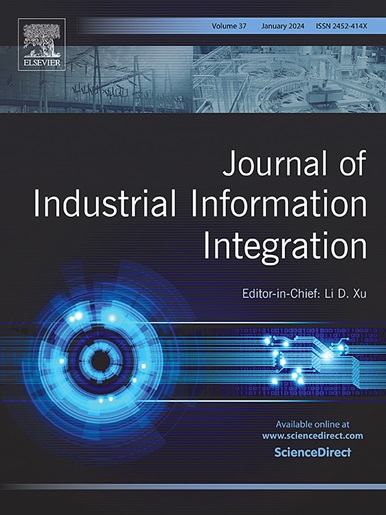LAECIPS:基于物联网的具体智能系统的大视觉模型辅助自适应边缘云协作
IF 10.4
1区 计算机科学
Q1 COMPUTER SCIENCE, INTERDISCIPLINARY APPLICATIONS
引用次数: 0
摘要
具身智能(EI)使制造系统能够灵活地感知、推理、适应并在动态的车间环境中运行。在智能制造中,典型的EI场景是机器人视觉检查,工业机器人必须准确检查快速变化的异构生产线上的组件。这项任务既需要高推理精度——特别是对于不常见的缺陷——也需要低延迟,以匹配生产速度,尽管照明、零件几何形状和表面条件不断变化。为了满足这些需求,我们提出了LAECIPS,这是一个基于物联网的具体智能系统的大视觉模型辅助自适应边缘云协作框架。LAECIPS将云中的大型视觉模型与边缘的轻量级模型解耦,支持灵活的模型部署和持续学习(自动模型更新)。LAECIPS通过识别复杂的检测案例,将复杂且不确定的检测案例路由到云端,同时在边缘处理日常任务,实现高精度和低时延。在真实世界的机器人语义分割系统上进行的视觉检测实验表明,与最先进的方法相比,在准确性、处理延迟和通信开销方面有了显著的改进。从工业信息集成的角度来看,LAECiPS为智能制造提供了一个完整的边缘-云信息循环:在边缘集成多源感知数据,自适应地将信息路由到云以获得大型模型辅助,并将提炼的知识反馈到边缘以进行持续适应。这种分层集成提高了准确性和受任务时间限制的延迟,与对可互操作和可扩展的工业信息集成的关注保持一致。本文章由计算机程序翻译,如有差异,请以英文原文为准。
LAECIPS: Large vision model assisted adaptive edge–cloud collaboration for IoT-based embodied intelligence system
Embodied intelligence (EI) enables manufacturing systems to flexibly perceive, reason, adapt, and operate within dynamic shop floor environments. In smart manufacturing, a representative EI scenario is robotic visual inspection, where industrial robots must accurately inspect components on rapidly changing, heterogeneous production lines. This task requires both high inference accuracy — especially for uncommon defects — and low latency to match production speeds, despite evolving lighting, part geometries, and surface conditions. To meet these needs, we propose LAECIPS, a large vision model-assisted adaptive edge–cloud collaboration framework for IoT-based embodied intelligence systems. LAECIPS decouples large vision models in the cloud from lightweight models on the edge, enabling flexible model deployment and continual learning (automated model updates). Through identifying complex inspection cases, LAECIPS routes complex and uncertain inspection cases to the cloud while handling routine tasks at the edge, achieving both high accuracy and low latency. Experiments conducted on a real-world robotic semantic segmentation system for visual inspection demonstrate significant improvements in accuracy, processing latency, and communication overhead compared to state-of-the-art methods. From an industrial information integration perspective, LAECiPS operationalizes a complete edge–cloud information loop for smart manufacturing: integrating multi-source perception data at the edge, adaptively routing information to the cloud for large model assistance, and feeding back distilled knowledge to the edge for continual adaptation. This layered integration improves both accuracy and task-time-constrained latency, aligning with the focus on interoperable and scalable industrial information integration.
求助全文
通过发布文献求助,成功后即可免费获取论文全文。
去求助
来源期刊

Journal of Industrial Information Integration
Decision Sciences-Information Systems and Management
CiteScore
22.30
自引率
13.40%
发文量
100
期刊介绍:
The Journal of Industrial Information Integration focuses on the industry's transition towards industrial integration and informatization, covering not only hardware and software but also information integration. It serves as a platform for promoting advances in industrial information integration, addressing challenges, issues, and solutions in an interdisciplinary forum for researchers, practitioners, and policy makers.
The Journal of Industrial Information Integration welcomes papers on foundational, technical, and practical aspects of industrial information integration, emphasizing the complex and cross-disciplinary topics that arise in industrial integration. Techniques from mathematical science, computer science, computer engineering, electrical and electronic engineering, manufacturing engineering, and engineering management are crucial in this context.
 求助内容:
求助内容: 应助结果提醒方式:
应助结果提醒方式:


